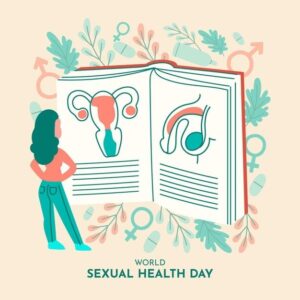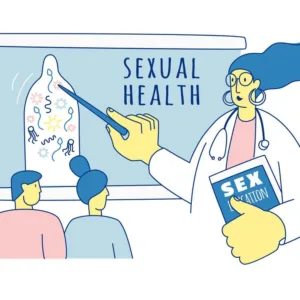Sex Education-“Breaking the important Myths: Debunking Common Misconceptions About Sex Education and Healthy Sexual Relationships” 2024
- Sex Education-“Breaking the important Myths: Debunking Common Misconceptions About Sex Education and Healthy Sexual Relationships”
- Let’s delve into the importance of comprehensive sex education and address some common myths and misconceptions.
- Myth: Sex Education Encourages Sexual Activity
- Myth 3: Sex Education is Only About Contraception and STIs
- Myth 4: Talking About Sex is Inappropriate for Young Children
- Myth 5: All Teens Already Know About Sex from the Internet
- Myth 6: Sex Education is Unnecessary Because Parents Should Teach Their Children About Sex
- Myth 7: Consent is Implied in Long-Term Relationships
- Let’s explore the fascinating ways in which men and women experience and express their sexuality. Understanding these differences can lead to healthier relationships and more informed sexual education.
- Myth 9: Pornography is a Realistic Depiction of Sex
- Educating About the Differences Between Porn and Real-Life Sexual Relationships
- Debunking the Myth: LGBTQ+ Topics Belong in Sex Education
- Comprehensive sex education plays a crucial role in promoting sexual health and well-being among students. Let’s explore how schools can implement effective programs and some successful examples:
- Successful Programs:
- Let’s delve into the intersection of media, technology, and sex education:
- Comprehensive sex education has a significant impact on public health. Let’s explore some key findings and benefits:
- Advocating for comprehensive sex education is essential to empower young people with accurate information and promote healthy relationships. Here are some tips for parents, educators, and community members:
- Let’s wrap up our discussion on comprehensive sex education with a concise summary and a call to action:
Sex Education-“Breaking the important Myths: Debunking Common Misconceptions About Sex Education and Healthy Sexual Relationships”
Let’s delve into the importance of comprehensive sex education and address some common myths and misconceptions.
- Comprehensive Sexuality Education (CSE):
- CSE provides young people with accurate, age-appropriate information about sexuality and sexual and reproductive health. It equips them with essential knowledge and skills to make informed decisions.
- Key aspects of CSE include understanding one’s body, gender identity, and sexuality; building healthy relationships; practicing effective communication; and making informed choices regarding sexual behavior.
- Myths and Facts (Sex Education) :
- Myth: Comprehensive sexuality education encourages youth to have sex.
- Fact: Research shows that CSE programs do not increase sexual activity or lead youth to engage in sex at an earlier age. These programs emphasize both abstinence and contraception, helping young people delay sexual initiation.
- Myth: CSE undermines parental authority.
- Fact: Most parents support comprehensive sexuality education. Schools complement parental roles by providing accurate information in a safe learning environment.
- Myth: CSE disregards values and morals.
- Fact: CSE incorporates cultural sensitivity and universal human rights. It does not undermine values but promotes informed decision-making.
- Myth: Comprehensive sexuality education encourages youth to have sex.

Sex Education-“Breaking the Myths: Debunking Common Misconceptions About Sex Education and Healthy Sexual Relationships”( image credit pinterest)
- Impact of Myths:
- Misconceptions can perpetuate harmful behaviors and attitudes. When we debunk myths, we empower young people to make healthier choices and foster respectful relationships.
Myth: Sex Education Encourages Sexual Activity
Debunking the Myth: Research consistently shows that comprehensive sex education (CSE) does not encourage sexual activity. In fact, it has the opposite effect:

Sex Education( image credit pinterest)
- Delaying Sexual Initiation (Sex Education):
- Studies reveal that young people who receive comprehensive sex education tend to delay their first sexual experience.
- CSE equips them with knowledge about contraception, consent, and healthy relationships, empowering them to make informed choices.
- Promoting Responsible Decisions (Sex Education):
- CSE emphasizes abstinence as well as safe sexual practices.
- It teaches young people about the risks of unprotected sex, sexually transmitted infections (STIs), and unintended pregnancies.
- Armed with accurate information, they are more likely to engage in responsible behaviors .
Myth 2: Abstinence-Only Education is the Most Effective Approach(Sex Education)
Debunking the Myth: Abstinence-only education, despite its intentions, falls short in achieving its goals. Let’s explore why:
- Ineffectiveness:
- Evidence: Research consistently shows that abstinence-only programs do not decrease rates of sexual activity or unplanned pregnancies when compared to comprehensive sex education.
- These programs often lack crucial information about contraceptives, sexually transmitted infections (STIs), consent, and healthy communication.
- By the end of high school, most teenagers have already had sex, rendering abstinence-only education inadequate.
- Comprehensive Sex Education (CSE):
- Effectiveness: Comprehensive sexuality education has a positive impact on sexual and reproductive health.
- Benefits: CSE reduces STIs, HIV, and unintended pregnancies. It also delays sexual activity without hastening it.
Myth 3: Sex Education is Only About Contraception and STIs
Debunking the Myth: Sex education encompasses far more than just contraception and sexually transmitted infections (STIs). Let’s explore its broader scope:
- Consent:
- Teaching young people about consent is crucial. They need to understand that any sexual activity requires clear, enthusiastic, and ongoing consent from all parties involved.
- Consent education emphasizes communication, boundaries, and respect.
- Healthy Relationships:
- Sex education delves into building and maintaining healthy relationships.
- Topics include effective communication, conflict resolution, empathy, and mutual support.
- Understanding emotional intimacy and connection is equally important.
- Emotional Well-Being:
- Sexuality education addresses emotional aspects.
- It helps young people navigate feelings, self-esteem, body image, and coping mechanisms.
- Emotional well-being impacts overall sexual health.
- Respect and Boundaries:
- Students learn to respect their own boundaries and those of others.
- They understand that consent can be withdrawn at any time.
- Boundaries extend beyond physical touch to emotional and digital spaces.
- Communication Skills:
- Effective communication is vital for healthy relationships.
- Sex education teaches active listening, expressing desires, and understanding nonverbal cues.
Myth 4: Talking About Sex is Inappropriate for Young Children
Debunking the Myth: Starting age-appropriate sex education early is essential for several reasons:
- Body Awareness:
- Children should learn about their bodies from an early age.
- Understanding body parts, functions, and changes helps them develop a healthy self-image.
- Boundaries and Consent:
- Teaching children about personal boundaries and respecting others’ boundaries is crucial.
- They learn that their bodies belong to them and that they have the right to say “no.”
- Respect and Empathy:
- Early education fosters empathy and respect for diversity.
- Children understand that everyone is unique and deserves kindness and understanding.
- Healthy Relationships:
- Discussions about friendship, family, and emotions lay the foundation for healthy relationships.
- Children learn about trust, communication, and mutual respect.
- Preventing Misconceptions:
- Addressing basic questions early prevents misconceptions.
- Honest, age-appropriate answers build trust and openness.

Sex Education (image credit pinterest)
Myth 5: All Teens Already Know About Sex from the Internet
Debunking the Myth: While the internet provides vast information, not all of it is reliable or accurate. Here’s why:
- Misinformation:
- Teens encounter conflicting information online, including myths and misconceptions.
- Unreliable sources may perpetuate harmful ideas about sex, relationships, and health.
- Lack of Context:
- Online content lacks context and personalized guidance.
- Teens need comprehensive education that addresses their unique needs and questions.
- Trusted Adults and Educators:
- Reliable sources include trusted adults (parents, teachers, healthcare providers) and educators.
- These individuals provide accurate, age-appropriate information and foster open conversations.
Myth 6: Sex Education is Unnecessary Because Parents Should Teach Their Children About Sex
Acknowledging Parental Role: Parents play a vital role in shaping their children’s understanding of sexuality. However, there are challenges:
- Gaps in Knowledge:
- Not all parents feel equipped to provide comprehensive sex education.
- Some lack accurate information or feel uncomfortable discussing certain topics.
- Cultural and Religious Factors:
- Cultural norms and religious beliefs may influence what parents teach.
- Professional sex education ensures a broader perspective.
- Structured Learning:
- Schools and educators offer structured, evidence-based sex education.
- This complements parental guidance and fills gaps.
Myth 7: Consent is Implied in Long-Term Relationships
Understanding Ongoing and Enthusiastic Consent: Consent is not a one-time agreement; it’s an ongoing process. Here’s why:
- Enthusiastic Consent:
- Enthusiastic consent means a wholehearted “yes.”
- It goes beyond mere compliance or silence.
- Partners actively express desire and willingness.
- Changing Boundaries:
- Consent can be reversed at any point.
- Respecting a partner’s “no” or desire to stop is crucial.
- Preventing Sexual Violence:
- Active consent helps prevent coercion and assault.
- A culture of clear communication fosters safety.
- Building Respectful Relationships:
- Consent education promotes mutual respect.
- It ensures both partners feel heard and valued.
Let’s explore the fascinating ways in which men and women experience and express their sexuality. Understanding these differences can lead to healthier relationships and more informed sexual education.

Sex Education-“Breaking the Myths: Debunking Common Misconceptions About Sex Education and Healthy Sexual Relationships”( image credit pinterest)
- Desire and Arousal:
- Men: Men often experience sexual desire more spontaneously. They may become aroused through visual cues, such as seeing an attractive person or explicit content.
- Women: Women, on the other hand, are less likely to become spontaneously sexually aroused. Their sexual desire is more reactive to their surrounding circumstances, emotional connection, and context.
- Physiological vs. Subjective Arousal:
- Men: Men’s physiological arousal (e.g., genital response) tends to align with their subjective feelings of attraction. If they’re physically aroused, they usually feel attracted to the stimulus.
- Women: For women, physiological arousal doesn’t always correlate directly with subjective attraction. Research shows that both straight women and lesbians exhibit similar physiological arousal patterns regardless of the gender of the stimulus. However, their subjective feelings of attraction may vary.
- Emotional Connection:
- Men: Men often prioritize physical oneness—sight, smell, and touch.
- Women: Women desire emotional oneness. They value connection, trust, and communication in addition to physical intimacy.
- Context Matters:
- Women’s Sexuality: Women’s desire is context-dependent. Factors like emotional closeness, safety, and relational dynamics significantly impact their sexual responsiveness.
- Men’s Sexuality: Men’s desire tends to be more straightforward and immediate, often triggered by visual stimuli or physical sensations.
Myth 9: Pornography is a Realistic Depiction of Sex
Discussing the Unrealistic and Often Harmful Portrayals of Sex in Pornography
Pornography is pervasive in modern society, and its impact on sexual expectations and behaviors cannot be ignored. While it is often consumed for pleasure, it is crucial to understand that pornography is a form of entertainment and not an accurate representation of real-life sexual relationships. Here are some key points highlighting the unrealistic and harmful portrayals of sex in pornography:
1. Unrealistic Physical Standards:
- Idealized Bodies: Porn often showcases performers with bodies that fit specific, often unattainable, standards of beauty and physical fitness. This can lead to unrealistic expectations about how people should look.
- Lack of Diversity: There is a significant lack of diversity in body types, ethnicities, and ages in mainstream porn, which does not reflect the real-world diversity of sexual partners.
2. Performance and Duration:
- Endurance and Stamina: Pornographic scenes often depict prolonged sexual encounters that can last for unrealistic lengths of time, which can create false expectations about sexual stamina and performance.
- Exaggerated Pleasure: Performers in porn often exaggerate their reactions to enhance the viewer’s experience. This can lead to misconceptions about what constitutes real sexual pleasure and responsiveness.
3. Consent and Communication:
- Lack of Verbal Communication: Porn rarely depicts the essential conversations about consent, boundaries, and mutual desires that are crucial for healthy sexual relationships.
- Consent Misrepresentation: In many pornographic scenes, consent is either implied or entirely absent, leading to harmful notions about when and how consent should be given and received.
4. Emotional Connection:
- Absence of Intimacy: Porn often focuses solely on physical acts without showing the emotional intimacy and connection that are fundamental to most real-life sexual experiences.
- Misrepresentation of Relationships: Porn typically does not portray the complexities of relationships, such as trust, love, and mutual respect, which play vital roles in healthy sexual interactions.
5. Sexual Practices and Norms:
- Risky Behaviors: Porn often features risky sexual behaviors without depicting the use of protection or discussing the importance of safe sex practices, potentially influencing viewers to neglect their own sexual health.
- Uncommon Acts: Certain sexual acts that are frequently depicted in porn may not be as common or desirable in real life. This can pressure individuals to engage in behaviors they are uncomfortable with or that do not align with their desires.
Educating About the Differences Between Porn and Real-Life Sexual Relationships
1. Open Communication:
- Encouraging Dialogue: Promote the importance of open and honest communication between partners about their desires, boundaries, and consent. This fosters a healthy and respectful sexual relationship.
- Seeking Consent: Emphasize the necessity of seeking and giving clear, enthusiastic consent in every sexual encounter.
2. Realistic Expectations:
- Body Positivity: Encourage body positivity and acceptance, highlighting that sexual attractiveness and satisfaction are not limited to specific physical standards.
- Normalizing Variety: Recognize that sexual experiences and preferences vary greatly among individuals and that there is no “right” way to engage in sexual activity.
3. Emotional Intimacy:
- Building Connection: Stress the importance of emotional intimacy and connection in sexual relationships, which contributes to overall satisfaction and fulfillment.
- Valuing Relationships: Highlight that healthy sexual relationships are built on trust, respect, and mutual care, which are often absent in pornographic portrayals.
4. Safe Practices:
- Promoting Safe Sex: Advocate for safe sex practices, including the use of protection and regular sexual health check-ups, to prevent STIs and unplanned pregnancies.
- Educating on Risks: Educate about the potential risks associated with certain sexual behaviors and the importance of making informed choices.
5. Critical Consumption:
- Media Literacy: Encourage critical thinking and media literacy when consuming pornographic content, helping individuals differentiate between entertainment and reality.
- Seeking Reliable Information: Promote the use of reliable sources for sexual education, such as educational programs, healthcare providers, and reputable websites.
Debunking the Myth: LGBTQ+ Topics Belong in Sex Education
Inclusivity Matters: LGBTQ+ inclusivity in sex education benefits all students, not just LGBTQ+ youth. Here’s why:
- Reducing Stigma:
- Inclusive education fosters understanding and acceptance.
- It combats harmful stereotypes and biases.
- Safer Schools:
- When students learn about diverse sexual orientations and gender identities, they intervene against bullying.
- Inclusive curricula create safer, more supportive school environments.
- Healthy Perspectives:
- Comprehensive sex education empowers students with accurate information.
- It promotes bodily autonomy, responsible decisions, and healthy relationships
Comprehensive sex education plays a crucial role in promoting sexual health and well-being among students. Let’s explore how schools can implement effective programs and some successful examples:
- Supportive Policies:
- Schools need policies that create a supportive environment for sexual health education.
- These policies ensure consistent implementation and address diverse student needs.
- Appropriate Content:
- Quality sexual health education curricula cover topics like healthy relationships, consent, contraception, and STIs.
- Evidence-based content should be age-appropriate and culturally relevant.
- Trained Staff:
- Well-qualified teachers and school staff deliver effective sex education.
- They engage students, address questions, and foster positive relationships.
- Engaged Parents and Communities:
- Involving parents and community partners ensures a holistic approach.
- Open communication helps reinforce learning at home and in the community.
Successful Programs:
- Comprehensive Sex Education: These programs cover a wide range of topics, including healthy relationships, consent, and sexual health. They empower students with accurate information and skills.
- Evidence-Based Approaches: Programs that incorporate health goals, preventive methods, risk factors, and safe environments have proven successful.
- Inclusive Curricula: Successful programs recognize diverse identities and experiences, explicitly discussing structural and cultural issues.
Let’s delve into the intersection of media, technology, and sex education:
- Media and Technology in Sex Education:
- Supportive Role: Social and digital media can be powerful tools to support sexual health education. Websites, apps, and online resources provide accessible information and resources for students.
- Media Campaigns: Well-designed media campaigns encourage healthy decisions related to sexual health. They can raise awareness, reduce stigma, and promote positive behaviors.
- Challenges and Opportunities:
- Misinformation: The internet is flooded with information, some of which may be inaccurate or harmful. Teaching critical media literacy skills is essential to help students discern reliable sources.
- Privacy Concerns: Digital platforms must balance accessibility with privacy. Ensuring confidentiality and safety is crucial.
- Engagement: Technology allows interactive learning experiences, quizzes, and videos. Engaging content keeps students interested and informed.
Comprehensive sex education has a significant impact on public health. Let’s explore some key findings and benefits:
- Reduced Teen Pregnancy Rates:
- Teens who receive comprehensive sex education are 50% less likely to experience pregnancy compared to those who receive abstinence-only education.
- Accurate information about contraception and reproductive health empowers young people to make informed choices.
- Fewer Lifetime Partners:
- Comprehensive programs lead to delayed first sexual experiences and fewer lifetime sexual partners.
- This contributes to lower risks of sexually transmitted infections (STIs) and unintended pregnancies.
- Increased Contraceptive Use:
- Education on contraceptive methods encourages responsible behavior.
- Students learn about various options, promoting safer sexual practices.
- Healthy Relationships and Consent:
- Comprehensive sex education addresses healthy relationships, consent, and communication.
- Understanding boundaries fosters respectful interactions.
- Long-Term Societal Benefits:
- Well-informed youth become healthier adults, reducing healthcare costs.
- Lower rates of STIs and unintended pregnancies benefit society as a whole.
Advocating for comprehensive sex education is essential to empower young people with accurate information and promote healthy relationships. Here are some tips for parents, educators, and community members:
- Contact Legislators:
- Reach out to your state legislators and express support for positive sex education policies.
- Share your vision for comprehensive sex education in schools and advocate for evidence-based curricula.
- Join School Advisory Committees:
- Participate in school board student health advisory committees.
- These bodies improve communication and transparency between students, parents, and educators.
- Engage with Schools:
- Collaborate with schools to implement or enhance sex education programs.
- Encourage policies that foster supportive environments for sexual health education.
- Educate the Community:
- Host workshops or informational sessions for parents and community members.
- Raise awareness about the importance of comprehensive sex education and dispel myths.
- Partner with Healthcare Providers:
- Work with local healthcare professionals to advocate for evidence-based sex education.
- Healthcare providers can offer insights and support to schools and parents.
Let’s wrap up our discussion on comprehensive sex education with a concise summary and a call to action:
- Key Points:
- Comprehensive sex education provides accurate information about sexual health, relationships, consent, and more.
- Debunking myths is crucial to dispel harmful misconceptions and promote informed decision-making.
- Inclusive education benefits everyone, regardless of sexual orientation or gender identity.
- Call to Action:
- Support Comprehensive Sex Education:
- Advocate for evidence-based, inclusive sex education in schools and communities.
- Encourage collaboration between educators, parents, and healthcare providers.
- Promote Open Conversations:
- Talk openly with young people about sexual health, consent, and healthy relationships.
- Create a safe space for questions and discussions.
- Support Comprehensive Sex Education:
In conclusion, breaking the myths surrounding sex education and healthy sexual relationships is crucial for fostering a well-informed and respectful society. Misconceptions about sex education can lead to misinformation, harmful behaviors, and unrealistic expectations, which ultimately impact individuals’ physical and emotional well-being. By debunking these myths, we can promote comprehensive, fact-based sex education that empowers individuals to make informed decisions, understand the importance of consent, and build healthy relationships grounded in respect and communication.
Sex education is not merely about preventing negative outcomes; it’s about equipping individuals with the knowledge and skills to navigate their sexuality with confidence and responsibility. It encompasses a wide range of topics, from the biological aspects of sex to the emotional and relational components, ensuring a holistic approach to sexual health and well-being.
As we move forward, it’s imperative that we advocate for comprehensive sex education programs that are inclusive, evidence-based, and age-appropriate. By doing so, we can challenge harmful stereotypes, reduce stigma, and create a culture where open dialogue about sex and relationships is normalized and encouraged.
Ultimately, breaking these myths will pave the way for healthier, happier, and more respectful sexual relationships for everyone. Let’s commit to supporting and promoting comprehensive sex education to ensure a brighter, more informed future for all.
More you visit: https://taazakhobor.in/
More you can read:
Offline vs Online Education. Which one is best for your children to score 91+%?
What are Mutual Funds? Are Mutual Funds safe to invest in 2024?
Neet scam 2024-The greatest educational scam in the history of India!!
Indian mythology-Mythical Marvels: Exploring India’s Ancient Gods and Goddesses
